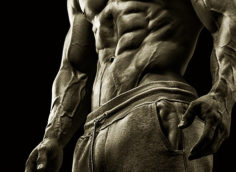The Best Training Techniques for Biceps
- Go Heavy. Since the biceps are comprised of even more growth-happy type II muscle fibers than the triceps (by at least 60%), they're more prone to grow when using heavy loads. A study by Lagally et al. found each jump in relative load (working from 30-90% of 1RM) resulted in superior muscle activation. This means if you want to get full contraction, use heavy, heavy weight.
- Pull Yourself Up. Whether or not you think you can build big biceps with compound lifts alone, the chin-up is an excellent biceps exercise. In fact, research shows the chin-up (palms facing you) activates the biceps to near maximal levels (Youdas et al. 2010). The biceps crave load and nothing beats the chin-up here.
- Let the Shoulders Come Forward. The long head of the biceps works incredibly well when you let the shoulder slightly flex and curl forward while in the standing position. Because of the strength curve, you'll have a peak contraction of the biceps around the mid-point of the lift, which coincides with its strongest position. Don't curl the barbell too high up, though (towards the shoulders), as you'll take a lot of the stress off the muscle.
- Rotate to Annihilate. The biceps supinate the forearm as well as flex the arm. When you force them to do both, you're providing maximal stimulus, especially to the short head (Staudenman et al. 2015).
- Sit and Stretch. The seated incline dumbbell curl is the ultimate biceps builder when it comes to the short head. The hyper-extended shoulder position stretches the long head (Oliveira et al. 2009), meaning the short head has to take up the extra work.
How Should You Train the Biceps?
Taking all those techniques into consideration, you should carpet-bomb the biceps with compound lifts and then get a little fancy in specifically targeting each of the two heads with a slight tweak in exercise selection.

- Use heavy loads to maximally activate the biceps and train the type II muscle fibers. Stick with the tried and true and perform the majority of your lifts with 3-8 RM.
- You should also start your biceps workout with the chin-up. You'll be able to steadily increase the loads over time and mark your progress accordingly.
- Hit up the long head of the biceps with standing barbell curls. Make sure to contract to at least 90 degrees of elbow flexion and squeeze with all you've got. Let the shoulders naturally flex as you curl rather than limiting the weight you can use by holding the arms by the side.
- Lastly, perform the seated incline curl with dumbbells. Start the lift with the palms facing the seat and rotate them as you curl.





